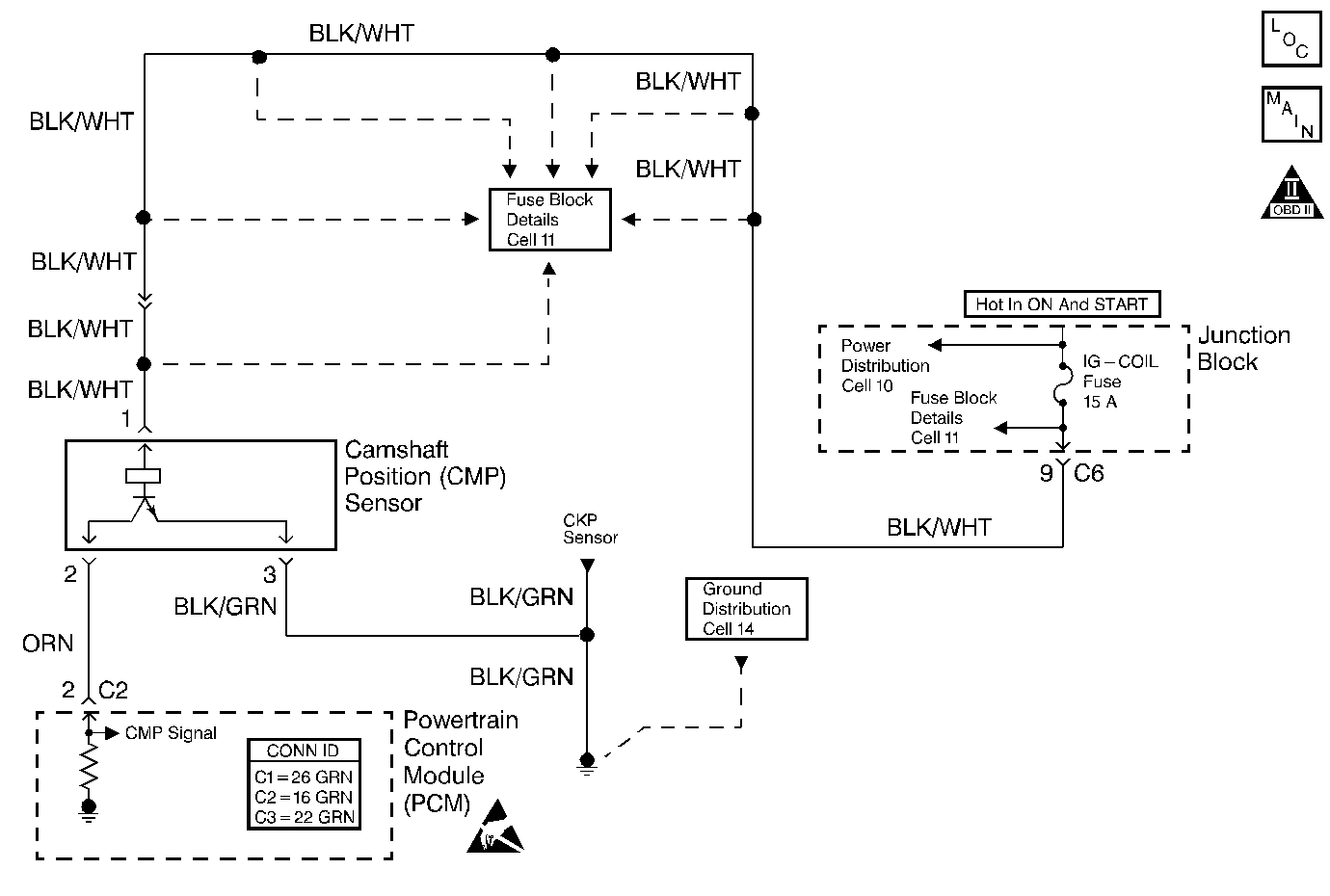
Circuit Description
The powertrain control module (PCM) receives voltage signals from the camshaft position (CMP) sensor. The PCM uses signals from the CMP sensor in order to identify the cylinders and performs misfire diagnostics. The CMP sensor generates the voltage signals from the rotation of the camshaft. A signal rotor, which rotates with the camshaft, crossing through the magnetic field of the CMP sensor. The movement of the signal rotor past the sensor creates a flux in the magnetic field. The CMP sensor responds to the change in the magnetic field and sends this information to the PCM.
Conditions for Setting the DTC
| • | If the PCM does not receive a signal from the CMP sensor with the engine cranking. |
| • | If the PCM does not receive a signal from the CMP sensor if the engine is running. |
| • | If the condition is present for 2 seconds. |
Action Taken When the DTC Sets
| • | The PCM illuminates the malfunction indicator lamp (MIL). |
| • | The PCM records the operating conditions at the time of the diagnostic failure. This information is stored in the Freeze Frame. |
Conditions for Clearing the MIL/DTC
| • | The MIL turns OFF after 3 consecutive trips, during which the diagnostic runs and the fault does not exist. |
| • | A History DTC clears after 40 consecutive warm-up cycles without a fault. |
Use a scan tool in order to clear the DTC. Disconnect the battery in order to clear the DTC.
Diagnostic Aids
Check the CMP sensor for damage or for foreign material. Remove any metal particles that are sticking to the sensor end.
An intermittent malfunction may be caused by a fault in the CMP sensor electrical circuit. Inspect the wiring harness and the components for any of the following conditions:
| • | Backed out terminals |
| • | Incorrect mating of terminals |
| • | Broken electrical connector locks |
| • | Deformed terminals or damaged terminals |
| • | A faulty terminal to wire connections |
| • | Physical damage to the wiring harness |
| • | A broken wire inside the insulation |
| • | Corrosion of electrical connections, corrosion of splices, or corrosion of terminals |
Use the information included in the Freeze Frame data, if you cannot duplicate the DTC P0335.
Test Description
The numbers below refer to the step numbers in the diagnostic table.
-
The Powertrain OBD system check requires the technician to complete some basic checks, and to save the freeze frame data. If the fault occurred, this creates an electronic copy of the data. The information is in the scan tool for later reference.
-
This step determines if a fault is present.
-
This step checks for a reference voltage at the CMP sensor.
-
This step checks the operation of the CMP sensor. Passing magnetic material at the front of the CMP sensor simulates the signal rotor. This action causes a response from the sensor. If a metal object passes at a distance of approximately 1 mm (0.03 in), the CMP sensor will switch from 0.0-1.0 volts to 4.0-5.0 volts
Step | Action | Value | Yes | No | ||||||
|---|---|---|---|---|---|---|---|---|---|---|
Did you perform the Powertrain On--Board Diagnostic (OBD) System Check? | -- | |||||||||
Does the scan tool indicate a DTC P0340? | -- | Go to Diagnostic Aids | ||||||||
3 |
Is the voltage at the specified value? | B+ | ||||||||
Measure the voltage from the harness side of the CMP sensor signal circuit to ground with the DMM. Is the voltage within the specified value? | 4-5 V | |||||||||
5 |
Did the test lamp illuminate? | -- | ||||||||
Does the DMM indicate that the CMP sensor signal is switching from the first specified value to the second specified value? | 0-1 V 4-5 V | |||||||||
7 |
Was a repair necessary? | -- | ||||||||
8 | Repair the open in the CMP sensor ignition circuit. Refer to Wiring Repairs in Wiring Systems. Is the action complete? | -- | - | |||||||
9 | Repair the open or the faulty connection in the CMP sensor ground circuit. Refer to Wiring Repairs in Wiring Systems. Is the action complete? | -- | - | |||||||
10 | Replace the CMP sensor. Refer to Camshaft Position Sensor Replacement . Is the action complete? | -- | - | |||||||
11 | Replace the PCM. Is the action complete? | -- | - | |||||||
12 |
Was a repair necessary? | -- | Go to Diagnostic Aids | |||||||
13 |
Are any DTCs present? | -- | Go to the applicable DTC table | System OK |
